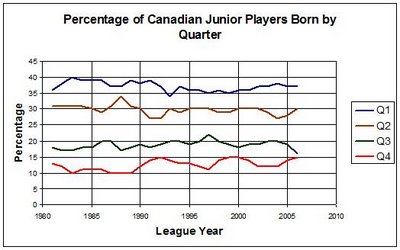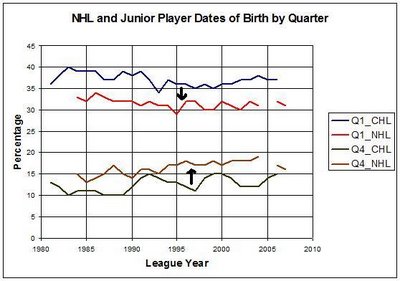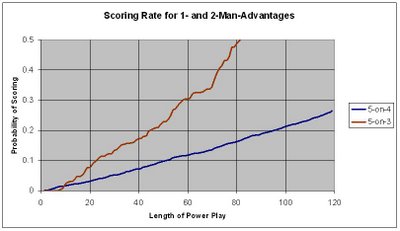Saturday, December 27, 2008
2008 Holiday Spending
Wednesday, December 24, 2008
The dangers of Overtime Losses
While the shootout and the overtime loss have probably made the NHL more exciting for fans, the way they're presented in the standings has made it very difficult to determine how good a team is. Right now, game outcomes are grouped into Wins, Losses and Overtime Losses so that we can see how many points a team has, but nobody tracks whether a team won its game in regulation or in overtime or the shootout. Some teams, like last year's Edmonton Oilers, can get incredibly lucky in the extra frames, leading to a record that's way out of line with their actual performance. This is a very key piece of information - there's no correlation between OT/SO performance and overall performance, a fact that's acknowledged by playing overtime indefinitely in the playoffs to decide a winner.
Lots of people understand that overtime wins can lead us to erroneous conclusions about a team, including the people who put the Toronto Maple Leafs 24th in this week's ESPN Power Rankings:
"Break up the Leafs! They're at a misleading, OTL-skewed .500."
Except, in this case, it's not true. Toronto's 2-6 this year after regulation, which makes them 12-14-8 in regulation - tied eight times after 8. Their regulation GF/GA: 107-116, giving an expected winning percentage of 0.460, which translates to 31.26 points in the standings, or 0.75 points less than that 12-14-8 record would suggest.
The Leafs may be a lot of things, but skewed-record-holders, they ain't.
Lots of people understand that overtime wins can lead us to erroneous conclusions about a team, including the people who put the Toronto Maple Leafs 24th in this week's ESPN Power Rankings:
"Break up the Leafs! They're at a misleading, OTL-skewed .500."
Except, in this case, it's not true. Toronto's 2-6 this year after regulation, which makes them 12-14-8 in regulation - tied eight times after 8. Their regulation GF/GA: 107-116, giving an expected winning percentage of 0.460, which translates to 31.26 points in the standings, or 0.75 points less than that 12-14-8 record would suggest.
The Leafs may be a lot of things, but skewed-record-holders, they ain't.
Thursday, December 11, 2008
Malcolm Gladwell's Outliers and making the NHL
In his book Outliers, Malcolm Gladwell discusses the odd distribution of birth months among NHL players. Because youth players are registered in leagues based on their year of birth, the biggest and strongest players tend to be those born in the first few months of the year. This selection process starts as early as age 8, and the effect persists more than a decade later in junior hockey in Canada. The effect has been visible for decades:

One thing that's very unintuitive about this effect is that, other things being equal, if you have a 17-year-old player who puts up the same number of points as an 18-year-old player, the 17-year-old will have a much higher performance ceiling. I like to call this the 'Wayne Gretzky-Dan Hodgson' effect - two players who had identical stats their last year in junior; but Gretzky was 16 and Hodgson was 19, and so it was obvious who would have the better NHL career.
At any rate, if you have identical junior players born in January and December, the December player was almost a year younger when he achieved his performance. If we project that performance forward to Age 23, then we'd expect the December player, on average, to be better. And this is an effect we see when we compare the birthdates of junior hockey players to NHL players:

The first time that players aren't strictly grouped by birthdate is when they reach professional leagues. At this point, younger players outperform older players by a wide margin, making the jump from junior hockey to the NHL at a 50% higher rate. Gladwell mentions in his ESPN interview that "Canada is squandering the talents of hundreds of boys with late birthdays." It seems pretty clear that he's right.

One thing that's very unintuitive about this effect is that, other things being equal, if you have a 17-year-old player who puts up the same number of points as an 18-year-old player, the 17-year-old will have a much higher performance ceiling. I like to call this the 'Wayne Gretzky-Dan Hodgson' effect - two players who had identical stats their last year in junior; but Gretzky was 16 and Hodgson was 19, and so it was obvious who would have the better NHL career.
At any rate, if you have identical junior players born in January and December, the December player was almost a year younger when he achieved his performance. If we project that performance forward to Age 23, then we'd expect the December player, on average, to be better. And this is an effect we see when we compare the birthdates of junior hockey players to NHL players:

The first time that players aren't strictly grouped by birthdate is when they reach professional leagues. At this point, younger players outperform older players by a wide margin, making the jump from junior hockey to the NHL at a 50% higher rate. Gladwell mentions in his ESPN interview that "Canada is squandering the talents of hundreds of boys with late birthdays." It seems pretty clear that he's right.
Labels: Gladwell, junior hockey
Tuesday, December 9, 2008
Scoring Probability vs Length of a 2-man advantage
I was asked recently about how the length of a 5-on-3 affects the rate at which teams score. Obviously, very few 5-on-3s run a full two minutes - it's both rare to take two penalties at once, and to successfully kill a two-man disadvantage. (In fact, it has only happened once so far during the 2008-09 season.) Here is the overall scoring rate this season for power plays versus the length of the man-advantage:

The way to read this is as follows - at 60 seconds, 30% of 2-man-advantages have resulted in a goal, while the rate is about 12% for 5-on-4s. That includes all goals scored in 60 seconds or less, and all power plays that have lasted 60 seconds or longer. If you're already on a 5-on-4 and there's a delayed penalty call against the other team, the break-even point for simply passing the puck to the other team is very low - certainly you should do it if you're looking at a 2-man-advantage of 15 seconds or longer.
This chart would look slightly different prior to the 2008-09 season. A rule change for this season puts all face-offs to start a power-play in a team's offensive zone, regardless of where the puck was touched by the offending team. In past, teams would have required another few seconds to move the puck up the ice on some power plays, and the scoring rate would have been shifted rightward in the first few seconds.
The way to read this is as follows - at 60 seconds, 30% of 2-man-advantages have resulted in a goal, while the rate is about 12% for 5-on-4s. That includes all goals scored in 60 seconds or less, and all power plays that have lasted 60 seconds or longer. If you're already on a 5-on-4 and there's a delayed penalty call against the other team, the break-even point for simply passing the puck to the other team is very low - certainly you should do it if you're looking at a 2-man-advantage of 15 seconds or longer.
This chart would look slightly different prior to the 2008-09 season. A rule change for this season puts all face-offs to start a power-play in a team's offensive zone, regardless of where the puck was touched by the offending team. In past, teams would have required another few seconds to move the puck up the ice on some power plays, and the scoring rate would have been shifted rightward in the first few seconds.
Labels: Power-play
Subscribe to Posts [Atom]
